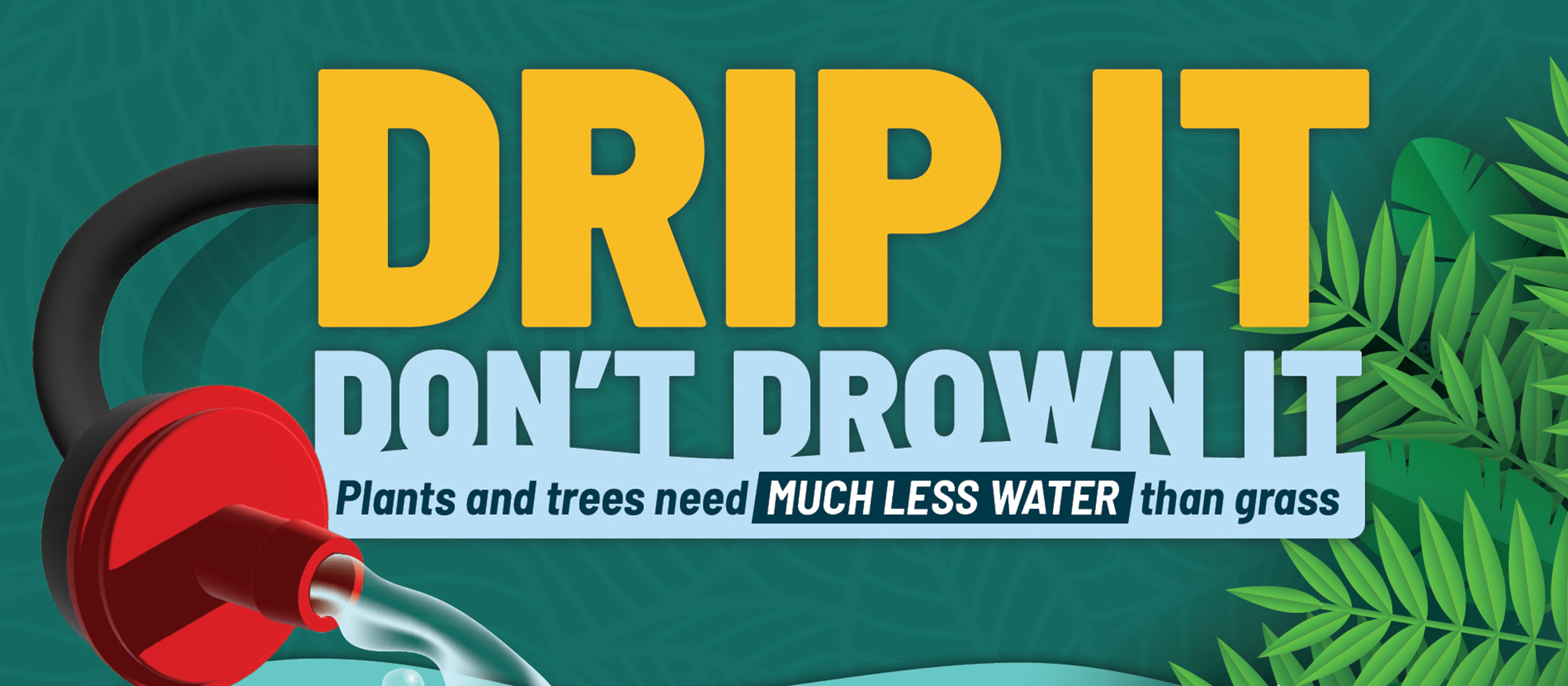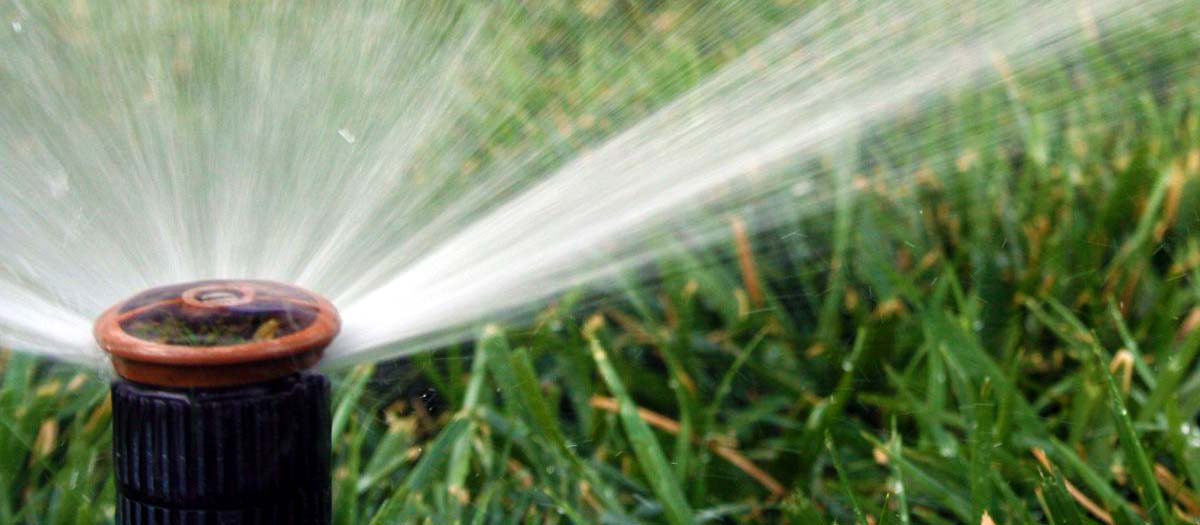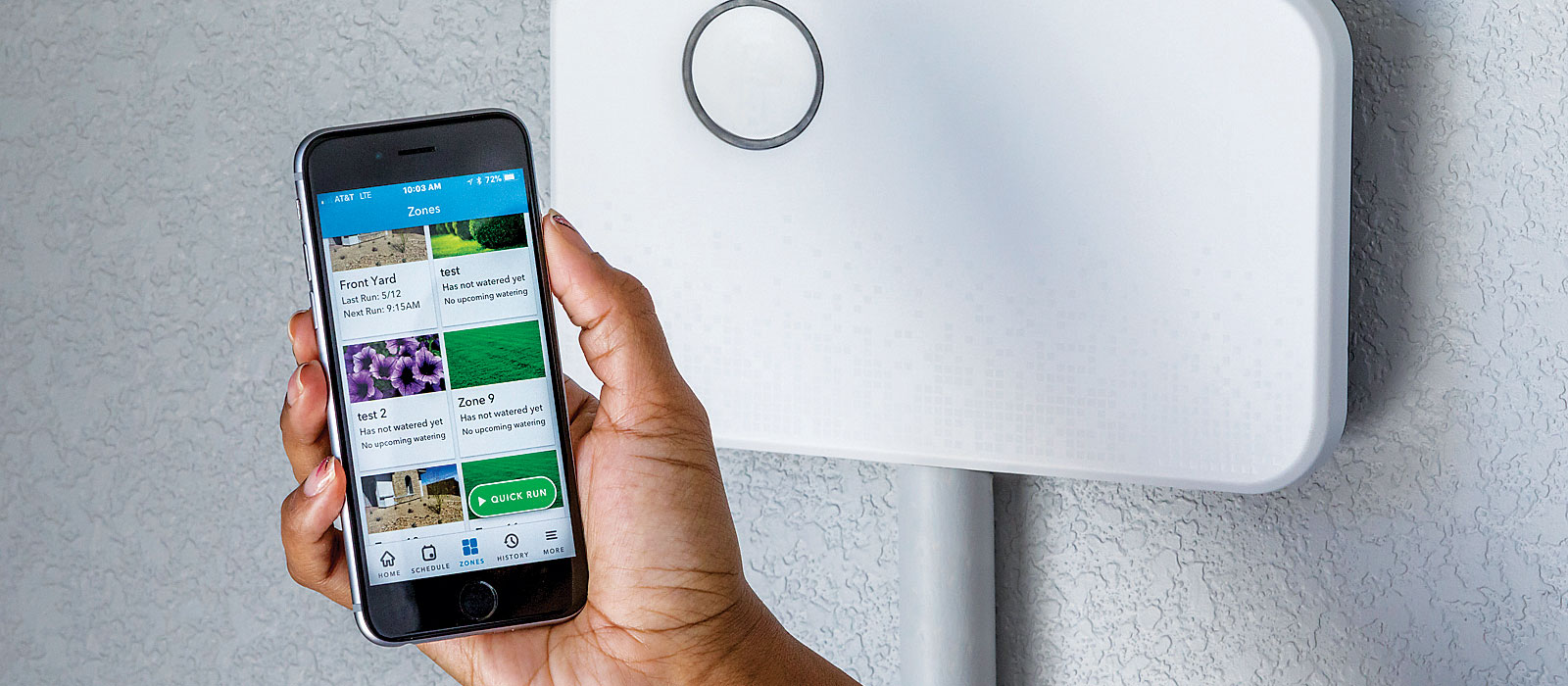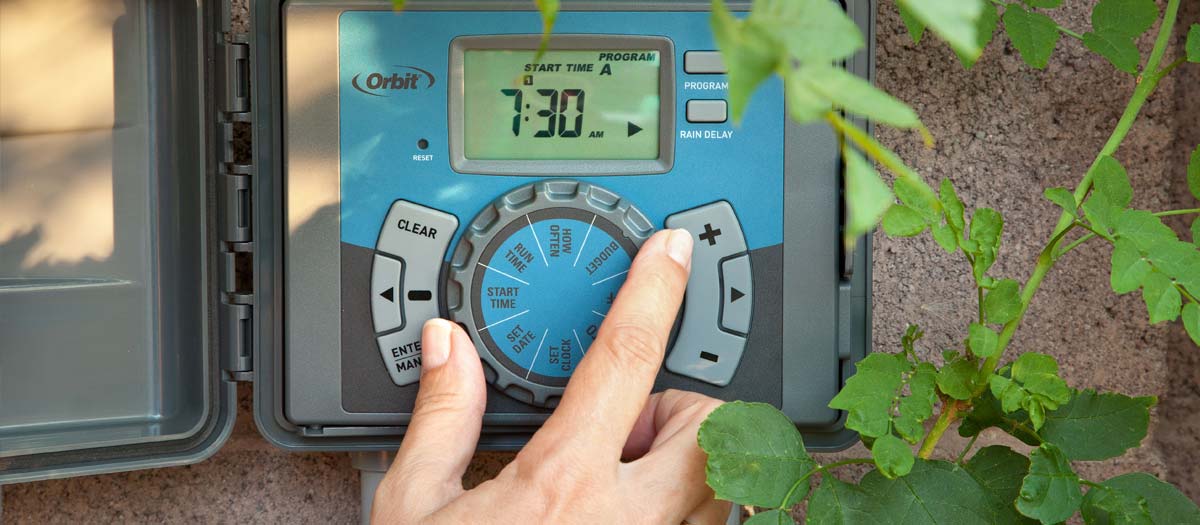Your irrigation system is the key to creating a healthy, water-efficient landscape. Find your assigned watering schedule and use the tips in this section to ensure you know how to water and when.

Are you overwatering your plants?
Drip irrigation systems deliver water more slowly and efficiently, and they should run longer but less frequently than sprinkler systems. The length of each watering should be determined by the emitter flow rate, soil type, and weather conditions.
It's easy to accidentally overwater your plants on drip systems! Browse our drip tips to determine the correct run times for your landscape.

12-minute sprinkler watering
Our parched desert soil makes it tough for water to soak in very deep. That's why we suggest three, 4-minute watering cycles.
The type of grass you have will determine how much water your lawn requires. Adding or removing one minute from a 4-minute sprinkler cycle, for example, will change the amount of water you use by 25 percent, which can have an impact on your water bill.

Trade in your old controller
Replace your old irrigation controller with a smart clock!
Smart irrigation clocks automatically adjust your watering according to the weather and many provide convenient access via mobile applications.
Investing in a smart irrigation controller is now easier than ever, thanks to our rebate, which offers 50 percent off the purchase price or up to $100, whichever is less.
Get more tips on how to set your irrigation controller.
Maintaining new landscapes
New plants need extra attention and watering as they take root in your yard. Mandatory watering restrictions allow for the extra watering of new plants for the first 14 days and hand-watering is allowed anytime.
During the first eight weeks, establish low-water-use and desert-adapted plants by following these watering suggestions.
- Weeks 1 & 2: Water every 1–2 days in summer, every 3–4 days in fall, winter and spring
- Weeks 3 & 4: Water every 3–4 days in summer, every 6–7 days in fall, winter and spring
- Weeks 5 & 6: Water every 4–6 days in summer, every 7–10 days in fall, winter and spring
- Weeks 7 & 8: Water every 7 days in summer, every 10–14 days in fall, winter and spring
- After week 8: Check plants for proper drainage and signs of stress and water based on need. Water new plants if the first two inches of soil is dry and check drip emitter placement.
Landscape tips
Use these tips to keep your landscape healthy no matter what the season.
- Adjust your irrigation clock seasonally and comply with mandatory watering restrictions.
- Use a drip irrigation system to water trees and shrubs and water appropriately. Experts agree that running drip irrigation less frequently is much better for plants than daily watering.
- Adjust sprinkler heads so they don't spray walls, driveways or sidewalks.
- Use the most efficient types of nozzles and irrigation clocks.
- Check the sprinkler system weekly and immediately replace broken or missing sprinklers with identical parts.
- Once a month, check the drip line for breaks and emitters for clogs or broken heads.
- For best results, shoot for "head-to-head" coverage. That means the spray of one sprinkler should reach the head of the sprinkler closest to it. Make sure grass does not block the spray. Level all sprinkler heads to grade to prevent spray blockage or tripping hazards.
- Turn your irrigation clock off on rainy days or replace it with a smart irrigation clock to do the work for you.
- Monitor how many minutes you can run your spray irrigation system before water begins to run off the property. Stop the cycle at that point. Allow the water to fully absorb before running another cycle.
- Water areas in the shade about 30 percent less than sunny areas.
- Visually assess plant health and address any problems. Hand-water stressed plants as needed.
- Fine tune watering times for each station to account for different watering requirements due to exposure, shade and sprinkler output.
- To eliminate runoff, set your irrigation clock to cycle 3 start times (no longer than 4 minutes each), 1 to 2 hours apart to allow water to soak into the soil. For example: water 3 times for 4 minutes, instead of 12 minutes all at once.
- Replace the backup battery on your irrigation clock at least once a year, possibly at the same time you replace batteries in your home's smoke detectors. Power outages can cause your irrigation clock to revert to its factory settings, often watering your landscape far more than it needs or is permitted by mandatory watering restrictions.
Winterize and protect your plants as the weather cools.
- Mandatory watering restrictions: During the winter, sprinkler irrigation is limited to one assigned day per week. Watering restrictions also apply to drip irrigation. Sunday is not an optional watering day. Find your watering group.
- Drip watering: Drip systems deliver water more slowly and efficiently than sprinklers, which means plants on drip irrigation should be watered less often than grass irrigated by sprinklers. The length of watering depends upon the type of drip emitter. Learn more about drip irrigation.
- Change all your clocks when Daylight Saving Time ends: Don't forget to change the time on your irrigation clock when daylight saving time ends on the first Sunday in November. Even better—get a rebate for a smart irrigation controller that will do it for you!
- Midmorning watering: Water in the midmorning to avoid the afternoon winds that keep your sprinklers from hitting their grass target. You also will reduce the risk of icing that can occur if you water during early morning or evening.
- Save water on rainy days: Turn your irrigation clock off on rainy days or let a smart irrigation clock do the work for you.
- Pruning: The ideal time to prune trees and shrubs is in late winter, when plants are mostly dormant. Finish heavy pruning by mid-February, before buds show evidence of swelling. Don't prune more than one-quarter of the living tissue during the year.
- Planting: February is usually mild enough to allow you to plant petunias, pansies, snapdragons and other cool-season annuals in a well-drained, highly enriched soil. Adding protective mulch on the soil around your plants will conserve water so you don't have to water as often.
- Leave damaged plants alone: If you notice frost or a freeze has damaged a plant, leave it alone until warmer weather arrives and new growth appears. Pruning or transplanting a damaged plant during winter months can hurt or even kill it.
- Revive roses: Fertilize established rose bushes now to encourage spring blooms and put down a 3-inch layer of mulch around each plant. Always water before and after applying fertilizer.
- Fertilize fruit plants: Peak blooming season is in the spring, and the best time to fertilize fruit trees and grapes is the six weeks before and after they bloom. Fertilize in late winter for the finest fruit.
- Protect pipes and hoses: There are several steps you can take to protect the pipes and hoses in your home and landscape from cold weather:
- Disconnect and drain garden hoses when they are not being used.
- Insulate your irrigation backflow device by draping a towel over it and cover with a bucket or other protective cover that touches the ground. Never obstruct or seal the ports of a backflow protection device.
- Wrap exposed irrigation pipes with pipe insulation, insulated "faucet socks," an old towel or duct tape.
- Set heat to 55 degrees when you're away to protect pipes and houseplants.
- Turn off the water valves to your washing machine to avoid flooding from burst hoses.
- Don't leave interior or exterior pipes dripping. Valley temperatures generally don't drop low enough for a long enough period of time to warrant it.
- Locate your water shut-off valve and learn how to turn off water at its source, so you can ward off damage from leaks or burst lines. Know how to turn off your irrigation backflow device as well.
- Pool tips: Reduce risks to your pool and/or spa from freezing conditions by following some of these tips:
- During freezing temperatures run the filtration pump and jet pumps continuously.
- Adjust pool and spa jets upwards to reduce surface freezing.
- Maintain proper pool water level at all times.
- Have all air and water leaks repaired.
- Remove and store all pool accessories in a clean, dry area.
- You should also consult with your pool maintenance company to see about winterizing your pool.
Get outdoors! Enjoy the nice weather by adding some new plants to your landscape.
- Mandatory watering restrictions: During March and April, landscape irrigation is limited to three assigned days per week. Watering restrictions also apply to drip irrigation. Sunday is not an optional watering day. Find your watering group.
- Drip watering: Drip irrigated landscapes need far less water than grass. We recommend watering two days a week in spring. The length of watering depends upon the type of drip emitter. Learn more about drip irrigation.
- Spring ahead for Daylight Saving Time: Don't forget to set your irrigation clock ahead an hour when daylight saving time begins on the second Sunday in March. This also is a great time to check your clock's batteries.
- Save water on rainy days: Turn your irrigation clock off on rainy days or replace it with a smart irrigation clock to do the work for you.
- Check your irrigation system: Inspect filter screens for damage and clean them by opening the end of the filter and running water through briefly. Then, soak the screens in a 50/50 water and vinegar solution if there is mineral buildup. To flush the irrigation lines, find the end cap and briefly run the system to flush out debris. Check valve boxes for debris buildup or muddy conditions indicating poor drainage.
- Planting: Spring is a fine time to explore what plants work best in your yard. Here are a few plants that we specifically recommend, and you can use our plant search tool to find more plants for your landscape.
- Valentine Emu Bush - Masses of tubular red flowers begin blooming in early February and continue into March. They like full sun.
- Cassia - This shrub's bright yellow blooms appear from January through March and sporadically the rest of the year.
- Rosemary - A good companion plant for the cassia, rosemary blooms during the same periods.
- Lavender - Expect blue spikes of color in spring and fall.
- Autumn Sage - Don't let the name fool you. This hummingbird favorite blooms all year, but most profusely from October through April.
- Sweet Acacia - Puffy yellowish-orange flowers perfume the air from February through April.
- Palo Verde - Count on a shower of golden-yellow blooms beginning in March.
- Desert Willow - Native to local washes, this tree is beloved by hummingbirds and bees and produces clusters of fragrant orchid-like blossoms, ranging from white to deep purple.
- Texas Mountain Laurel - This tree's large purple clusters of wisteria-like flowers look as good as they smell.
In summer, protect your heat-stressed landscape with these smart, efficient watering tips.
- Mandatory summer watering restrictions: From May 1 through Aug. 31, mandatory watering restrictions prohibit landscape irrigation between the hours of 11 a.m. and 7 p.m. Watering is allowed Monday through Saturday. Watering on Sundays is always prohibited. Find your watering group.
- Drip watering: Drip irrigated landscapes need far less water than grass. You may only need to water plants and desert landscapes every other day in summer. The length of watering depends upon the type of drip emitter. Learn more about drip irrigation.
- Ramp up summer watering gradually: The impulse to crank up landscape watering is strong when temperatures get hotter, but grass, trees and plants don't need as much water as you might think. In May, while nights are still cool, gradually increase your sprinkler watering from three days to four. From there, keep an eye on your landscape and increase watering only as needed into June, July and August.
- Water before sunrise: Water in early morning hours before sunrise to minimize the amount of water lost to evaporation and daytime winds.
- Run sprinklers for 12 minutes: We recommend watering lawns three times a day for four minutes during each watering.
- Save water on rainy days: Turn your irrigation clock off on rainy days or replace it with a smart irrigation clock to do the work for you.
- Brown spots: Most brown spots are caused by faults in the sprinkler system. Mixed types of sprinkler heads, blocked spray patterns, improper spacing and the system's pressure can all affect your lawn. Check your irrigation system to ensure it is providing "head to head" coverage, and hand-water brown spots until the issue can be resolved.
- Leaf scorching and burning: Leaves usually are stressed because of improper watering or improper fertilization. Since both over watering and under watering can damage plant leaves, the best solution is to water deeply and infrequently. This allows oxygen in the soil, washes salts away and encourages deep rooting. Make sure you have the right fertilizer both for your specific plants and for the time of year. Some fertilizers release much faster in hot weather, increasing the potential for damage.
In the fall, a little groundwork is essential to keeping your yard water-efficient and looking great.
- Mandatory watering restrictions: From Sept. 1 through Oct. 31, landscape watering is limited to three assigned days per week. Watering restrictions also apply to drip irrigation. Sunday is not an optional watering day. Find your watering group.
- Drip watering: Drip irrigated landscapes need far less water than grass. We recommend watering two days a week in fall. The length of watering depends upon the type of drip emitter. Learn more about drip irrigation.
- Run sprinklers for 12 minutes: Water your lawn in three short, four-minute cycles during the early-morning hours. As weather cools, water in several, short mid-morning cycles to prevent ice formation on driveways and walks.
- Save water on rainy days: Turn your irrigation clock off on rainy days or replace it with a smart irrigation clock to do the work for you.
- Check your irrigation system: Inspect filter screens for damage and clean them by opening the end of the filter and running water through briefly. Then, soak the screens in a 50/50 water and vinegar solution if there is mineral buildup. To flush the irrigation lines, find the end cap and briefly run the system to flush out debris. Check valve boxes for debris buildup or muddy conditions indicating poor drainage.
- Fertilizing: Fertilize in late September or early October with a balanced mix of nitrogen, phosphorous and potassium. Fertilizer not only improves turf quality, root growth and color—it also builds cold resistance into your grass.
- Aerating: Compacted soils are common in the Las Vegas Valley. Aerate grass in September or October to boost water penetration, reducing runoff on slopes and helping water and fertilizer nutrients get down to the roots. Moisten grass a day or two before aerating to soften the soil. Using a coring aerator, make two to three passes to aerate severely-compacted soil to its proper depth of at least 3 inches. Space aeration holes about 3 inches apart. Leave soil cores on the grass after you aerate. Your mower will spread them around and back into the soil with the next mowing.
- Planting: For great fall color, plant flowers like the black-eyed Susan and snapdragon, grasses like Regal Mist and trees like the Chinese pistache and Modesto ash. If you're the patient type, purchase fall bulbs now for planting in November. These bulbs will yield bright colors in the spring: Anemone, Daffodil, Dahlia, Gladiolus, Hyacinth, Narcissus, Ranunculus and Tulips. Explore a wide variety of plants for your landscape using our plant search.
- Mulch: Mulch is the little-noticed workhorse of many a smart gardener's landscape. Mulch is a protective covering—organic or inorganic—we place in a wide circle around plants to prevent moisture evaporation, root freezing and weed growth. Using mulch can reduce evaporation by as much as 30 percent.
🌳Tree maintenance
Tree care during conversion
Existing, mature trees are a valuable and attractive part of any landscape. Unfortunately, a tree's root system can be disturbed during a landscape conversion or other construction project. Roots left behind lose the temperature buffer and water source provided by the lawn and the sprinkler system, which leads to drying and additional root loss.
Follow these tips to ensure trees are protected:
-
Convert during the cool season, if possible
-
Identify and protect major roots
-
Use weed killer and a de-thatcher to remove grass around trees
-
Establish a protective barrier around the tree to avoid damage
-
Avoid trenching under the canopy
-
Use a drip system to supply water under the canopy and out to the drip line
-
If a weed barrier is needed, use landscape fabric
-
Install mulch correctly
Caring for trees after turf removal
As you transition from a water-intensive grass lawn to desert landscaping through our Water Smart Landscapes Rebate, there are crucial steps you need to take to protect precious trees.
Haven't applied for the rebate yet?
SPEAKING FOR THE TREES: Star Nursery experts share tree tips for landscape upgrades
Episode 36 - March 6, 2023
Trees are an important part of our community and urban environment, especially as we face a hotter, drier future in Southern Nevada.
To protect our water supply, many residents and business owners are replacing water-thirsty grass with water-smart landscapes, but the upgrade process can put trees in jeopardy.
On this episode of the Water Smarts podcast, Star Nursery experts Dr. Q and Joey Lynn Watt talk about how to shield trees during a landscape conversion and best practices to keep the trees thriving after completing the upgrade.
